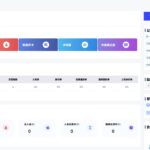You can check if a domain name is penalized by google at the following website:
https://ismywebsitepenalized.com

In cross-border business operation, whether the domain name is penalized by Google is an important factor that affects the website traffic and the effect of overseas market expansion. For foreign trade and cross-border industry practitioners, timely detection of domain name anomalies and investigate potential risks is a key link to maintain the stability of online business. The following combines hands-on experience to introduce effective methods and reference tools to determine whether a domain name is penalized by Google.
I. Basic troubleshooting: analysis of traffic and ranking fluctuations
The first step is to monitor changes in core website metrics through Google Search Console (GSC) and third-party data analytics tools (e.g., Ahrefs, SEMrush). If you find that the natural search traffic appearsNon-Seasonal Cliff DropIf your domain name has been penalized, and the ranking of your main keywords has dropped significantly (e.g., from the first page to the tenth page), you need to be alert to the fact that your domain name may have been penalized. Need to pay attention to distinguish whether the traffic fluctuations caused by algorithm updates (such as Google core algorithm adjustment) or content competitiveness decline, can be excluded by comparing the performance of similar websites in the same industry external factors.
Second, tool testing: authoritative platform verification
Get a quick report on the health status of your domain with the help of a professional testing tool. Recommended Usehttps://ismywebsitepenalized.comThe tool generates a visual assessment by analyzing the status of the domain in the Google index, the quality of the backlinks and the history of penalties. The steps are as follows:
- Enter the domain name to be detected (different forms with and without www are supported);
- Submit and wait for the system to capture the data (usually takes 1-3 minutes);
- Check the results page: if it shows "Penalty Detected" or similar warning, it indicates that the domain name is at risk of being penalized; if it suggests "Clean Status", no abnormality has been detected for the time being.
III. Manual verification: search result feature recognition
In addition to tool assistance, this can be further confirmed by visualizing the Google search results page:
- site command detection: Type "site:yourdomain.com", observe whether the number of included pages is consistent with the data in GSC background. If the number of included pages decreases suddenly (e.g. by more than 50%) and there is no clear reason for content adjustment, it may be a signal of penalty.
- Home page ranking anomaly: If the website does not appear in the first three positions on the home page when searching for a brand word or a specific product word (not a new website or in the cold start stage), or even disappears completely from the search results, it is necessary to investigate whether the penalty mechanism has been triggered due to irregularities in the operation.
IV. Common types of punishment and response logic
If it is confirmed that the domain name has been penalized, further distinction needs to be made between the types of penalties:
- algorithmic penaltyGoogle's algorithm automatically identifies and lowers a site's rankings for issues such as low-quality content, keyword stacking, and link farms. GSC's "Optimization Suggestions" module can be used to locate specific problems, such as removing spam links and optimizing content quality.
- manual punishment: In case of serious violations (e.g. copycat infringement, malicious bouncing), Google will send a manual penalty notification via the GSC notification bar. In this case, you need to submit a detailed rectification plan, which will be confirmed by Google audit team before you can restore your privileges.
V. Risk prevention and control recommendations
- Compliance operations preferredAvoid black hat SEO practices (e.g., buying links, hidden text) and regularly review content for compliance and link quality.
- Regularization of data monitoring: Review the GSC's "Search Traffic" and "Coverage" reports at least once a week, and set thresholds for traffic anomaly alerts (e.g., a single-day drop of more than 20% triggers an alert).
- Alternate Domain Name PolicyFor core business domain names, protective domain names (e.g. prefixes/suffixes) can be registered in advance to minimize the impact of a single domain name risk on the overall business.
For cross-border practitioners, domain name health management is a necessary course for long-term refined operation. It is recommended to combine tool detection with manual analysis and establish a standardized risk screening process to cope with the dynamic regulatory requirements of Google's search engine and safeguard the sustainability of online business.











